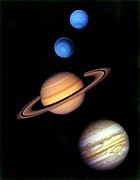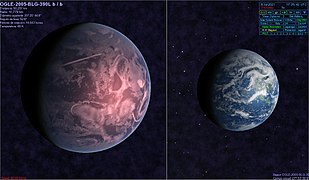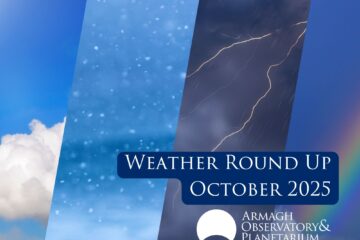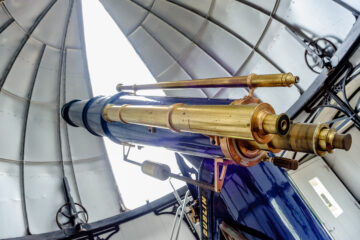
A size comparison of the planets in our Solar System. Image Credit: Wikimedia Commons
We all know about the planets in our solar system inside and out (especially if you’ve been to the planetarium!), but what about those mysterious and spooky bodies in a galaxy far far away…? There are many planets outside our solar system (but most are still within the milky way – not really in a galaxy far far away).

Swiss Scientists Mayor and Queloz, who discovered the first exoplanet. Image Credit: Wikimedia commons
The first was discovered in 1995, by Swiss astronomers Mayor and Queloz, who later shared the Nobel prize for their discovery. By now, there have been over 5000 planets confirmed outside our solar system, and another 7000 which have yet to be confirmed – we have learned that planets outnumber stars in the milky way! Which is saying something, since there are billions of stars in the milky way. This mind-boggling fact was discovered by the Kepler space telescope, which was trained on a small patch of sky for nine years and revolutionized our understanding of the universe, collecting huge datasets ripe for analysis. Kepler discovered lots of systems in the milky way in its goal of looking for earth-like planets or planets in the habitable zone of their star.

The Kepler Space Telescope. Image Credit: Wikimedia Commons
There are a few types of planet even just in our solar system alone, with Earth making up one of the four rocky planets, and the four outer planets falling into the ‘gas giant’ category (although Uranus and Neptune may be more accurately described as ‘ice giants’ given their temperature and distance from the sun). And then of course there are the dwarf planets, which may not be officially planets, but they are planets in our hearts (long live Pluto!). I mean really. What do they expect when ‘planet’ is still in the name!

The interior of three of the rocky planets in our solar system. Image Credit: Wikimedia Commons

The four gas giant planets in our solar system. Image Credit: Wikimedia Commons
But anyway, there are a number of types of exoplanet that have been discovered and classified so far. The first two types are ones we are familiar with: gas giant and terrestrial (rocky planet, earth sized or smaller). Within the gas giant category there is a type of planet that seems to be quite common – hot Jupiters. These are planets physically like Jupiter but that orbit very close to their star, making them warmer. They are also tidally locked – just like the moon is tidally locked to Earth: the same side always faces towards the star/its day and year are the same length.
The last twor types are less familiar, but still based on our solar system – Neptunians and super-Earths. Neptunians are Neptune-sized planets (as you might have guessed) but they have a rocky, heavy metal rich core. They have hydrogen and helium rich atmospheres, similar to Uranus and Neptune, but without the water, ammonia and methane. At least as far as we can tell – they tend to have thick cloudy atmospheres which make it difficult to see exactly what’s going on. And they come in miniature as well – sub-Neptunes or mini-Neptunes are on the smaller end of the scale.
Finally we have the super-Earth type planets, which, despite the name, are not similar to Earth. The name only refers to their size – they are bigger than Earth. Anywhere from twice the size of Earth to 10 times the size. Composition wise though, they are wild cards – anything from a gassy surface to icy worlds. There is a bit of overlap at the larger end of the scale with mini-Neptunes – some planets could fall into either category.
But many of the planets discovered are decidedly NOT suitable for life – these are the deadly worlds, that orbit outside the ‘Goldilocks zone’, too close or too far from their star. But some are more deadly than others. Here we’ve rounded up the 5 scariest exoplanets there are, and some of these are truly terrifying!

Image showing where the habitable zone, or ‘Goldilocks zone’ of our solar system lies. Red is too close to the sun, or too hot, green is the habitable area (just right) and blue is too far from the sun or too cold. Image Credit: Wikimedia Commons.
Proxima b

An artist’s impression of Proxima b as an arid, rocky super Earth. Image Credit: Wikimedia Commons
So this planet was thought at one point to be ‘Earth-like’ – but we have more recently realized that though it may be earth-like in certain respects, it is not earth-like in that it is unsuitable for life as we know it. We think that it might be terrestrial, with a rocky surface like earth, but it is bigger than Earth and orbits a cool red dwarf star. Because the star is cooler, the planets tend to orbit closer to the star, and Proxima b has a short year – zipping round its sun in just 11 days. Because of its proximity to the star, it is likely to be tidally locked, which doesn’t preclude life entirely, but certainly makes it more difficult.

Proxima b compared with Earth. Image Credit: Wikimedia Commons
The real kicker for this planet is the amount of radiation it receives. Potentially up to sixty times as much X-ray radiation as Earth, and this is enough to strip the atmosphere away from the planet slowly but surely. But that’s not all. There are strong stellar winds buffeting the planet, up to 80 times as much stellar wind as Earth – only exacerbating the stripping away of the atmosphere. We are unsure if the planet even has a magnetic field – this would protect the planet somewhat.
The exoplanet orbits the star Proxima Centauri, which is the closest star to our sun, our next door neighbour, if you will. Only 4 light years away, and the closest known exoplanet to Earth! But even if we crack light speed travel, it will take us four years to get to this star and this planet – better hope for a warp drive.

Proxima Centauri. Image Credit: Wikimedia Commons
HD 189733b

An artist’s impression of the deep blue planet HD 189733b. Image Credit: Wikimedia Commons
HD 189733b is a hot Jupiter (and so is tidally locked) and while it may appear innocent and friendly to life with its Cobalt blue surface, it is not. It is whipping around its star once every 2 days, causing gales of up to 5,400 mph on its surface. And there are scorching rainstorms constantly. But the rain on this planet isn’t water – instead shards of glass pelt sideways in the strong wind, pummeling and slashing any potential life that may unknowingly wander too close! And the atmosphere of this planet is huge – fading to blue as you get closer to the centre. But it is also being lost – stripped away from the planet bit by bit by the UV and X-ray radiation from its sun.
And the system it belongs to is only 63 light years away from us here on Earth –we could basically pop on round for a wee visit!
OGLE-2005-BLG-390Lb

OGLE-2005-BLG-390Lb compared with Earth. Image Credit: Wikimedia Commons
What a name! NASA frequently call this planet Hoth to give it a name that is easier to say, and you’ll understand why they chose that particular name shortly. This small planet orbits its parent star once every 10 earth years, at a distance of (very roughly -we don’t know enough to narrow it down yet) 300 to 600 million km. We don’t know much about the composition of this planet yet either; it could be made of gas or a rocky planet – but we do know that it is about 5 times earth’s mass, and that it is deathly cold. The temperature of this planet probably hovers somewhere in the region of -220 degrees Celsius, due to its distance from its sun (by the way, the lowest temperature possible is absolute zero, -273 degrees Celsius – this world comes pretty close!). Just to put it in perspective, if you were to breathe in on this planet, your lungs would collapse and kill you instantly. Hence Hoth.

An artist’s impression of OGLE-2005-BLG-390Lb. Image Credit: Wikimedia Commons
55 Cancri e

An artist’s impression of 55 Cancri e. Image Credit: Wikimedia Commons
55 Cancri e is a super-Earth, which orbits really close to its star, making one orbit every 18 hours. Because the planet is so close to its star (55 Cancri A), it is tidally locked (sensing a pattern?). The planet is nearly 9 times the size of Earth and was the first super-Earth to be discovered around a main sequence star. It was also the first exoplanet to successfully have its atmosphere analysed, so we know a bit more about it. What the Hubble detected when it looked at this planet was that there is hydrogen and helium in its atmosphere, but no water vapour. There have been debates over the likelihood of various compositions for this planet – but the consensus lately is that it is a lava world. Oceans of lava flow over the daytime side of the planet and sparkle in the sky on the night time side. The surface temperature on the daytime side of this planet is nearly 2000 degrees Celsius, and on the nighttime side it falls to a ‘chilly’ 1400 degrees Celsius.

An imagined tourist poster created by NASA for the planet 55 Cancri e. Image credit: Wikimedia Commons
This is another exoplanet within striking distance (41 light years) of earth – a prime candidate for further study.
Wasp-12b

An artist’s impression of WASP-12b. Image Credit: Wikimedia Commons
Wasp-12b is another hot planet (over 2000 degrees C) orbiting its (sun-like) star very closely. This is a hot Jupiter, tidally locked to its star with a huge amount of heat flow from the daytime side to the nighttime side, causing strong gales on the planet. The scariest thing about this planet though, is what its sun is doing to it. The planet orbits so close to its star that the star is tearing the planet’s atmosphere away from it so fast that the planet is likely to be destroyed completely within 10 million years. Not only that but the tidal forces are so strong that the planet is being distorted and pulled out of shape, becoming egg shaped as material is dragged towards its star, while the planet’s orbit slowly but surely degrades, falling into its sun.
Honourable mention – Rogue worlds: exoplanets on the loose.
Rogue planets, or free-floating planets, are a scary thought even on their own. These planets have no star, so they have either been ejected from their original solar system, or eerily, have never had a host star at all and have just formed in space just the way stars do. This means that they accrete slowly over thousands of years due to the slow accumulation of mass, and therefore gravity. However, these planets do not accumulate enough mass to begin fusion at their core, and so cannot be classified as stars. Some people call these planets sub-brown dwarfs – brown dwarfs are bodies that are not massive enough to carry out fusion of ordinary hydrogen, like stars, but are big enough to carry out some fusion of deuterium. They are the objects midway between a planet and a star, and some rogue planets are just smaller than these almost-stars. Estimates for how many rogue (or orphan) planets there are in the milky way range from a billion to a trillion – certainly they aren’t as rare as you might think. Definitely has potential to be the setting for an interstellar horror film.

An artist’s impression of a rogue exoplanet. Image Credit: Wikimedia Commons
So from friendly worlds to not so friendly ones, there is a lot still to learn about bodies outside our own solar system. Thanks to great projects like the Kepler space telescope, we are finding exoplanets faster than we can confirm them, so I don’t doubt that we will be discovering new planets and systems for a long time yet!



0 Comments